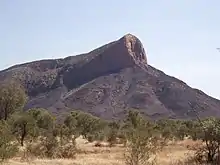Gabriella Possum Nungurrayi
Gabriella Possum Nungurrayi (born in 1967) is a contemporary Indigenous Australian artist born in the Papunya community, she followed in her father Clifford Possum Tjapaltjarri's footsteps and became an internationally respected painter. Examples of her work are held in many gallery collections in Australia and elsewhere, including the National Gallery of Australia, the Flinders University Art Museum, the Kelton Foundation Collection, the Museum & Art Gallery of the Northern Territory and the Royal Collection.[1]
Gabriella Possum Nungurrayi | |
|---|---|
| Born | 1967 |
| Nationality | Australian |
| Known for | Painting |
| Movement | contemporary Indigenous Australian art |
Early life
Gabriella Possum Nungurrayi is the eldest daughter of Indigenous Australian artist Clifford Possum Tjapaltjarri. Born in 1967 in Papunya, around 2.4 km northwest of Alice Springs in the community formed in the 1930s when Pintupi and Luritja people were forced off their traditional land and moved into Hermannsburg and Haasts Bluff. Her language is Anmatyerre.[2] She spent her early life in Alice Springs, where she began painting with her father from a very young age.[3][4]
Career

When she was 16 In 1985, Nungurrayi won the Alice Springs Art Award.[5]
Throughout her life Nungurrayi has been exhibiting work in Australia and overseas. In 1991 Nungurrayi received a Professional Development Grant from the Aboriginal Arts Unit of the Australia Council for the Arts, which helped her to develop her recognisable style showing dotted landscapes featuring elements such as bush foods familiar to her people. As her work was shown at higher profile galleries, collectors became interested in her work.[6]
As indigenous art from Australia gained more recognition, Nungurrayi's talent was recognised in a number of international shows. In 2006, she was one of the 33 artists showing at the National Museum of Women in the Arts, which was the first major US presentation of art by indigenous women in Australia.[7] In 2010 Nungurrayi showed work in the Down Under Gallery in Munich, Germany.[8]
In 2008 Nungurrayi's work found an international audience when celebrity gardener Jamie Durie won the Gold Medal in the Chelsea Flower Show. When HRH Queen Elizabeth gave Durie the prize she was presented with an original work by the artist, which now hangs in the royal collection alongside that of her father.[9][10]
At the 2014 Melbourne festival her work was used to decorate a tram as part of a major public art project called Melbourne Art Trams.[11]
At Vivid Sydney 2016, Nungurrayi's work was selected by director of the "Lighting of the Sails" installation, meaning her images were projected onto the Sydney Opera House along with five other Indigenous artists, Karla Dickens, Djon Mundine, Reko Rennie, Donny Woolagoodja, and Gulumbu Yunupingu.[12]
Her sister, Michelle Possum Nungurrayi is also a renowned artist. They exhibited together in 2017 at the Japingka gallery in Perth in 2017.[13]
Personal life
Since the early 2000s, Nungurrayi has lived near to Melbourne with her family.[14] The sale of her father's piece "Warlugulong" earned her significant resale royalty, which was seen as a fitting change made possible by the Australian resale royalty right movement, which sought to prevent financial exploitation of indigenous artists.[3][15] Danny Ramzan of the Australian hip hop group Yung Warriors is Nungurrayi's son.[16]
References
- "Gabriella Possum Nungurrayi (b. 1967) - Grandmothers Country - Bush Tucker Dreaming and Yams". www.royalcollection.org.uk. Retrieved 21 August 2018.
- Stourton, Patrick Corbally; Stourton, Nigel Corbally (1996). Songlines and dreamings: contemporary Australian aboriginal painting : the first quarter century of Papunya Tula. Lund Humphries. p. 66. Retrieved 21 August 2018.
- BOLAND, MICHAELA. "Possum first to receive royalty from artwork resale scheme". Retrieved 21 August 2018.
- Johnson, Vivien (2010). Once Upon a Time in Papunya. University of New South Wales Press. p. 23. ISBN 9781742240138. Retrieved 20 August 2018.
- "Gabriella Possum Nungurrayi - Artist Biography". www.kateowengallery.com. Retrieved 20 August 2018.
- Newstead, Adrian (2014). The Dealer is the Devil: An Insiders History of the Aboriginal Art Trade. Brandl & Schlesinger. pp. 217–218. ISBN 9781921556449.
- (U.S.), National Museum of Women in the Arts; Art, Hood Museum of (2006). Dreaming Their Way: Australian Aboriginal Women Painters. National Museum of Women in the Arts. pp. 56–57. ISBN 9781857594423. Retrieved 22 August 2018.
- Directory, Aboriginal Art. "Aboriginal art gallery in Munich at News Aboriginal Art Directory. View information about Aboriginal art gallery in Munich". news.aboriginalartdirectory.com. Retrieved 22 August 2018.
- Directory, Aboriginal Art. "Gabriella Possum Nungurrayi Australian Aboriginal Artist featured in Top 200 Australian Aboriginal Artists presented by the Aboriginal Art Directory Gallery". gallery.aboriginalartdirectory.com. Retrieved 22 August 2018.
- Gadd, Denise (15 March 2008). "Durie's out on how to make gardeners love the natives". The Age. Retrieved 21 August 2018.
- Spring, Alexandra (24 October 2014). "Melbourne festival 2014: one perfect day". the Guardian. Retrieved 22 August 2018.
- Taylor, Andrew (27 May 2016). "Vivid Sydney 2016: Lighting of the Sails at the Sydney Opera House". The Sydney Morning Herald. Retrieved 22 August 2018.
- "Talking about Country – Possum Sisters - Exhibition at Japingka". Japingka Aboriginal Art Gallery. Retrieved 21 August 2018.
- "Desert Paintings : Gabriella POSSUM NUNGURRAYI: Grandmother's Gold Country". www.aboriginaldream.com. Retrieved 21 August 2018.
- Rimmer, Matthew (2015). Indigenous Intellectual Property: A Handbook of Contemporary Research. Edward Elgar Publishing. p. 218. ISBN 9781781955901.
- Minestrelli, Chiara (2016). Australian Indigenous Hip Hop: The Politics of Culture, Identity, and Spirituality. Routledge. p. 116. ISBN 9781317217534.